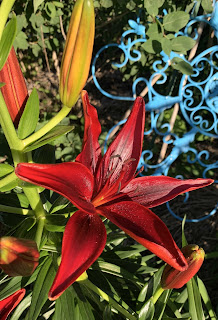The gorgeous little blush pink darling seen here to the right is the second bloom of one of two seedlings I was able to keep alive this year, from the first tiny sprout in late February clear through to transplantation into the garden proper. I'm disturbed that I had better light this morning (see the movie at the bottom), but had my iPhone set to "video" and when I went to rephotograph her for this afternoon, the weather is cloudy, and sprinkling, and the light is terrible for her.
Her first bloom, shown to the left as she opened in late April, showed me a lot of promise, a full double with delicate petals of a faint pink hue, but I am more thrilled to see now that she is remonant, blooming again today with two other buds waiting in the wings.She's been healthy so far, protected from the rabbits by her milk jug collar and under full Kansas sun, and the bloom at the top appears undamaged by our heat and the rain, but of course she has to go a long way to prove herself before I trouble to name her. Most important will be her winter hardiness, for I will not protect her from weather, just from marauding deer as the fall approaches. A chicken wire cage is coming soon!
I have another new seedling, planted a few yards away, also healthy but she has yet to bloom. Of course, I have no idea of the provenance of either rose although the foliage of each resembles its sister; both are the unknown orphans of a bunch of rose hips gathered in a hurry as the winter closed in and planted into a peat moss garden in the house under artificial lights. Most of the hips were from Hybrid Rugosas, but neither seedling shows any signs yet of Rugosa heritage. From her appearance, the one that has bloomed looks most like the English Rose 'Heritage' from my garden, the same delicate petals, similar bloom color and leaf form. Sadly, I have no idea if I grabbed hips from 'Heritage' during my fall frenzy.





















